Google & Apple: Managerial Accounting and Financial Statement Analysis
VerifiedAdded on 2023/05/29
|5
|1087
|289
Report
AI Summary
This report provides a managerial accounting analysis of Google and Apple, focusing on key expenses like research & development and sales & marketing, and evaluating their business models as service-based (Google) versus merchandising-based (Apple). The analysis explores the necessity of rationalizing costs while maintaining competitive advantage and also discusses the limited utility of activity-based costing for these companies, given their outsourcing strategies and core competencies in innovation and design rather than traditional manufacturing. The report concludes that while cost control is important, strategic investments in R&D and marketing are crucial for both companies' success, and that their business models dictate different approaches to cost management.
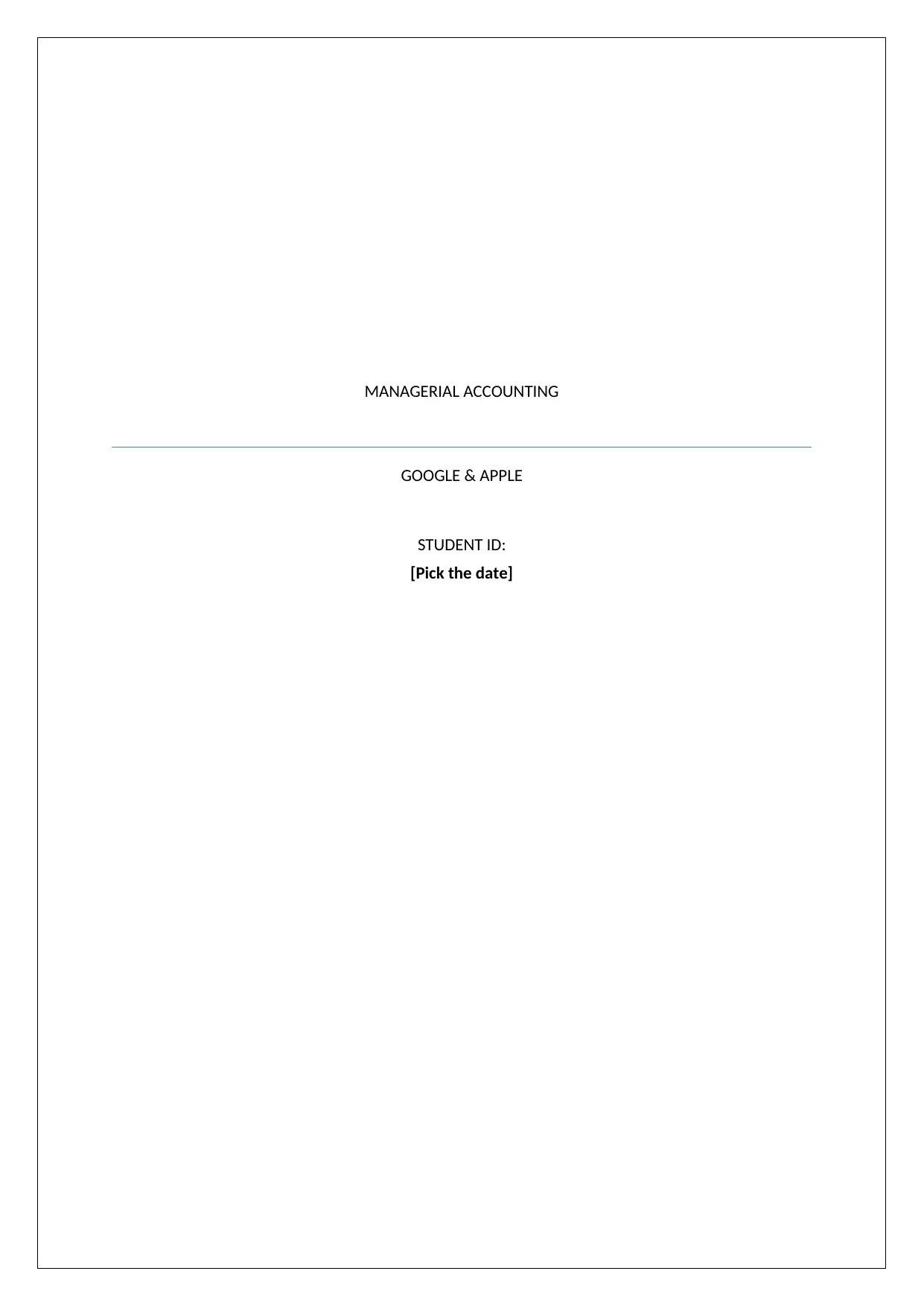
MANAGERIAL ACCOUNTING
GOOGLE & APPLE
STUDENT ID:
[Pick the date]
GOOGLE & APPLE
STUDENT ID:
[Pick the date]
Paraphrase This Document
Need a fresh take? Get an instant paraphrase of this document with our AI Paraphraser
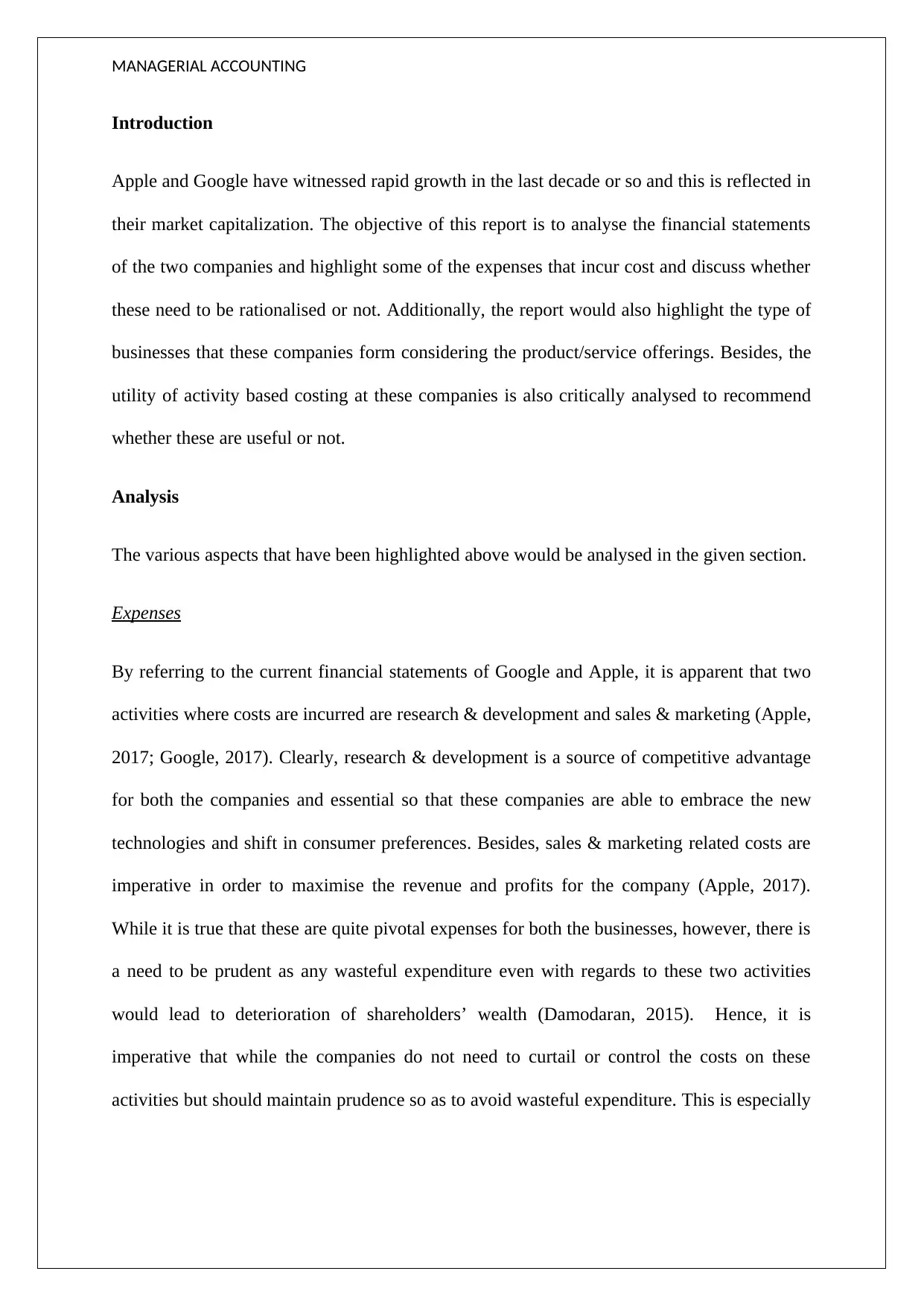
MANAGERIAL ACCOUNTING
Introduction
Apple and Google have witnessed rapid growth in the last decade or so and this is reflected in
their market capitalization. The objective of this report is to analyse the financial statements
of the two companies and highlight some of the expenses that incur cost and discuss whether
these need to be rationalised or not. Additionally, the report would also highlight the type of
businesses that these companies form considering the product/service offerings. Besides, the
utility of activity based costing at these companies is also critically analysed to recommend
whether these are useful or not.
Analysis
The various aspects that have been highlighted above would be analysed in the given section.
Expenses
By referring to the current financial statements of Google and Apple, it is apparent that two
activities where costs are incurred are research & development and sales & marketing (Apple,
2017; Google, 2017). Clearly, research & development is a source of competitive advantage
for both the companies and essential so that these companies are able to embrace the new
technologies and shift in consumer preferences. Besides, sales & marketing related costs are
imperative in order to maximise the revenue and profits for the company (Apple, 2017).
While it is true that these are quite pivotal expenses for both the businesses, however, there is
a need to be prudent as any wasteful expenditure even with regards to these two activities
would lead to deterioration of shareholders’ wealth (Damodaran, 2015). Hence, it is
imperative that while the companies do not need to curtail or control the costs on these
activities but should maintain prudence so as to avoid wasteful expenditure. This is especially
Introduction
Apple and Google have witnessed rapid growth in the last decade or so and this is reflected in
their market capitalization. The objective of this report is to analyse the financial statements
of the two companies and highlight some of the expenses that incur cost and discuss whether
these need to be rationalised or not. Additionally, the report would also highlight the type of
businesses that these companies form considering the product/service offerings. Besides, the
utility of activity based costing at these companies is also critically analysed to recommend
whether these are useful or not.
Analysis
The various aspects that have been highlighted above would be analysed in the given section.
Expenses
By referring to the current financial statements of Google and Apple, it is apparent that two
activities where costs are incurred are research & development and sales & marketing (Apple,
2017; Google, 2017). Clearly, research & development is a source of competitive advantage
for both the companies and essential so that these companies are able to embrace the new
technologies and shift in consumer preferences. Besides, sales & marketing related costs are
imperative in order to maximise the revenue and profits for the company (Apple, 2017).
While it is true that these are quite pivotal expenses for both the businesses, however, there is
a need to be prudent as any wasteful expenditure even with regards to these two activities
would lead to deterioration of shareholders’ wealth (Damodaran, 2015). Hence, it is
imperative that while the companies do not need to curtail or control the costs on these
activities but should maintain prudence so as to avoid wasteful expenditure. This is especially
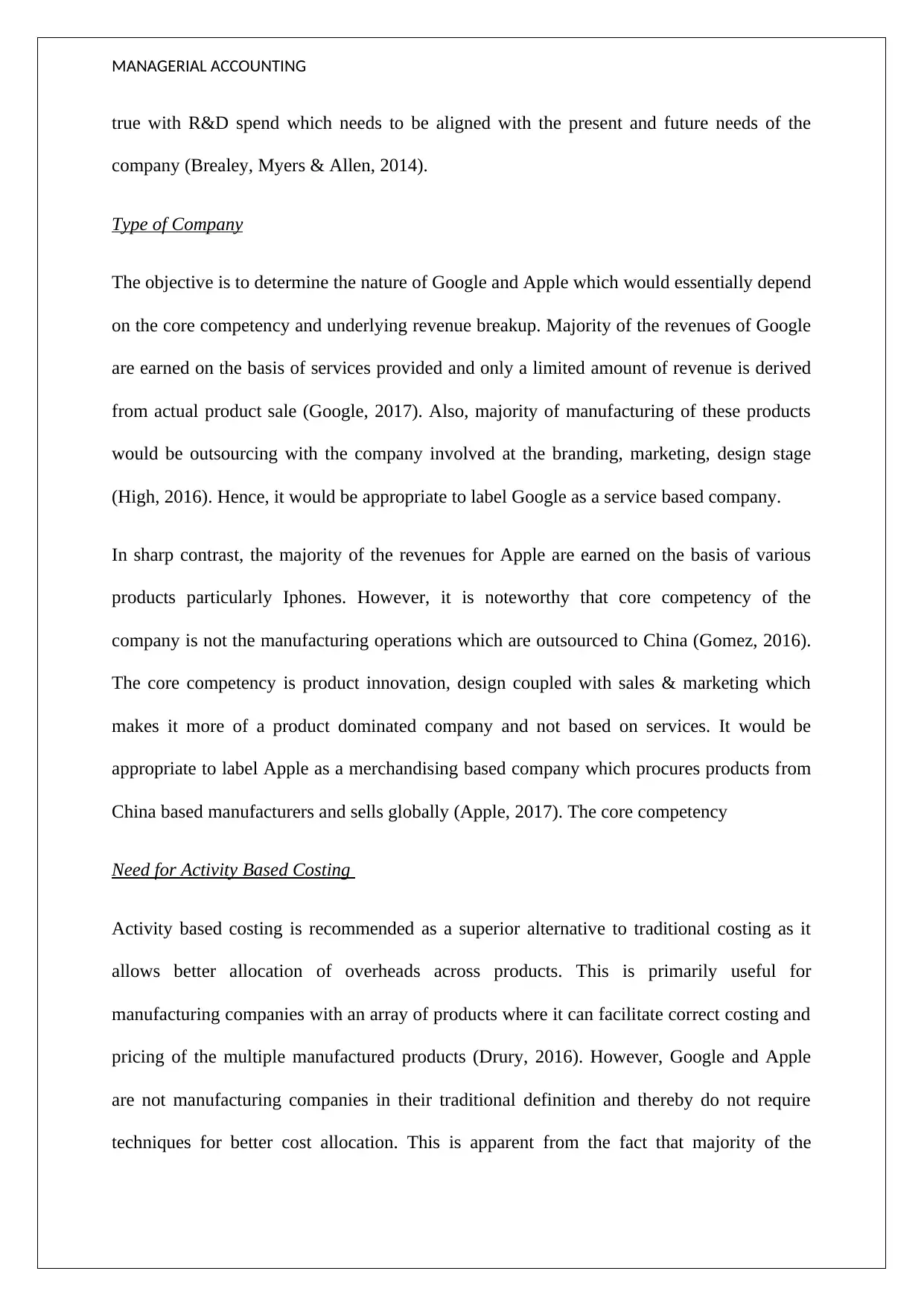
MANAGERIAL ACCOUNTING
true with R&D spend which needs to be aligned with the present and future needs of the
company (Brealey, Myers & Allen, 2014).
Type of Company
The objective is to determine the nature of Google and Apple which would essentially depend
on the core competency and underlying revenue breakup. Majority of the revenues of Google
are earned on the basis of services provided and only a limited amount of revenue is derived
from actual product sale (Google, 2017). Also, majority of manufacturing of these products
would be outsourcing with the company involved at the branding, marketing, design stage
(High, 2016). Hence, it would be appropriate to label Google as a service based company.
In sharp contrast, the majority of the revenues for Apple are earned on the basis of various
products particularly Iphones. However, it is noteworthy that core competency of the
company is not the manufacturing operations which are outsourced to China (Gomez, 2016).
The core competency is product innovation, design coupled with sales & marketing which
makes it more of a product dominated company and not based on services. It would be
appropriate to label Apple as a merchandising based company which procures products from
China based manufacturers and sells globally (Apple, 2017). The core competency
Need for Activity Based Costing
Activity based costing is recommended as a superior alternative to traditional costing as it
allows better allocation of overheads across products. This is primarily useful for
manufacturing companies with an array of products where it can facilitate correct costing and
pricing of the multiple manufactured products (Drury, 2016). However, Google and Apple
are not manufacturing companies in their traditional definition and thereby do not require
techniques for better cost allocation. This is apparent from the fact that majority of the
true with R&D spend which needs to be aligned with the present and future needs of the
company (Brealey, Myers & Allen, 2014).
Type of Company
The objective is to determine the nature of Google and Apple which would essentially depend
on the core competency and underlying revenue breakup. Majority of the revenues of Google
are earned on the basis of services provided and only a limited amount of revenue is derived
from actual product sale (Google, 2017). Also, majority of manufacturing of these products
would be outsourcing with the company involved at the branding, marketing, design stage
(High, 2016). Hence, it would be appropriate to label Google as a service based company.
In sharp contrast, the majority of the revenues for Apple are earned on the basis of various
products particularly Iphones. However, it is noteworthy that core competency of the
company is not the manufacturing operations which are outsourced to China (Gomez, 2016).
The core competency is product innovation, design coupled with sales & marketing which
makes it more of a product dominated company and not based on services. It would be
appropriate to label Apple as a merchandising based company which procures products from
China based manufacturers and sells globally (Apple, 2017). The core competency
Need for Activity Based Costing
Activity based costing is recommended as a superior alternative to traditional costing as it
allows better allocation of overheads across products. This is primarily useful for
manufacturing companies with an array of products where it can facilitate correct costing and
pricing of the multiple manufactured products (Drury, 2016). However, Google and Apple
are not manufacturing companies in their traditional definition and thereby do not require
techniques for better cost allocation. This is apparent from the fact that majority of the
⊘ This is a preview!⊘
Do you want full access?
Subscribe today to unlock all pages.

Trusted by 1+ million students worldwide
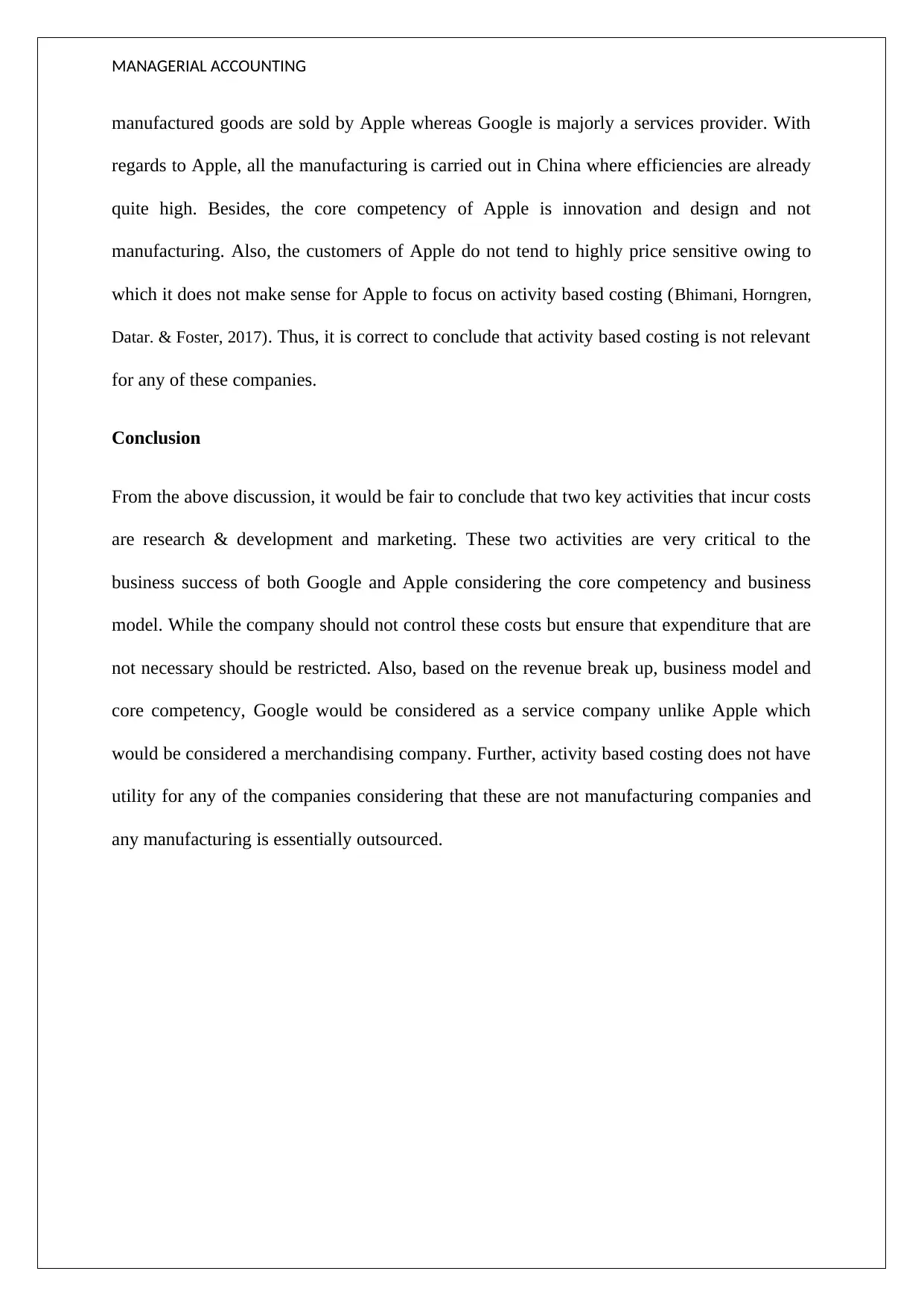
MANAGERIAL ACCOUNTING
manufactured goods are sold by Apple whereas Google is majorly a services provider. With
regards to Apple, all the manufacturing is carried out in China where efficiencies are already
quite high. Besides, the core competency of Apple is innovation and design and not
manufacturing. Also, the customers of Apple do not tend to highly price sensitive owing to
which it does not make sense for Apple to focus on activity based costing (Bhimani, Horngren,
Datar. & Foster, 2017). Thus, it is correct to conclude that activity based costing is not relevant
for any of these companies.
Conclusion
From the above discussion, it would be fair to conclude that two key activities that incur costs
are research & development and marketing. These two activities are very critical to the
business success of both Google and Apple considering the core competency and business
model. While the company should not control these costs but ensure that expenditure that are
not necessary should be restricted. Also, based on the revenue break up, business model and
core competency, Google would be considered as a service company unlike Apple which
would be considered a merchandising company. Further, activity based costing does not have
utility for any of the companies considering that these are not manufacturing companies and
any manufacturing is essentially outsourced.
manufactured goods are sold by Apple whereas Google is majorly a services provider. With
regards to Apple, all the manufacturing is carried out in China where efficiencies are already
quite high. Besides, the core competency of Apple is innovation and design and not
manufacturing. Also, the customers of Apple do not tend to highly price sensitive owing to
which it does not make sense for Apple to focus on activity based costing (Bhimani, Horngren,
Datar. & Foster, 2017). Thus, it is correct to conclude that activity based costing is not relevant
for any of these companies.
Conclusion
From the above discussion, it would be fair to conclude that two key activities that incur costs
are research & development and marketing. These two activities are very critical to the
business success of both Google and Apple considering the core competency and business
model. While the company should not control these costs but ensure that expenditure that are
not necessary should be restricted. Also, based on the revenue break up, business model and
core competency, Google would be considered as a service company unlike Apple which
would be considered a merchandising company. Further, activity based costing does not have
utility for any of the companies considering that these are not manufacturing companies and
any manufacturing is essentially outsourced.
Paraphrase This Document
Need a fresh take? Get an instant paraphrase of this document with our AI Paraphraser
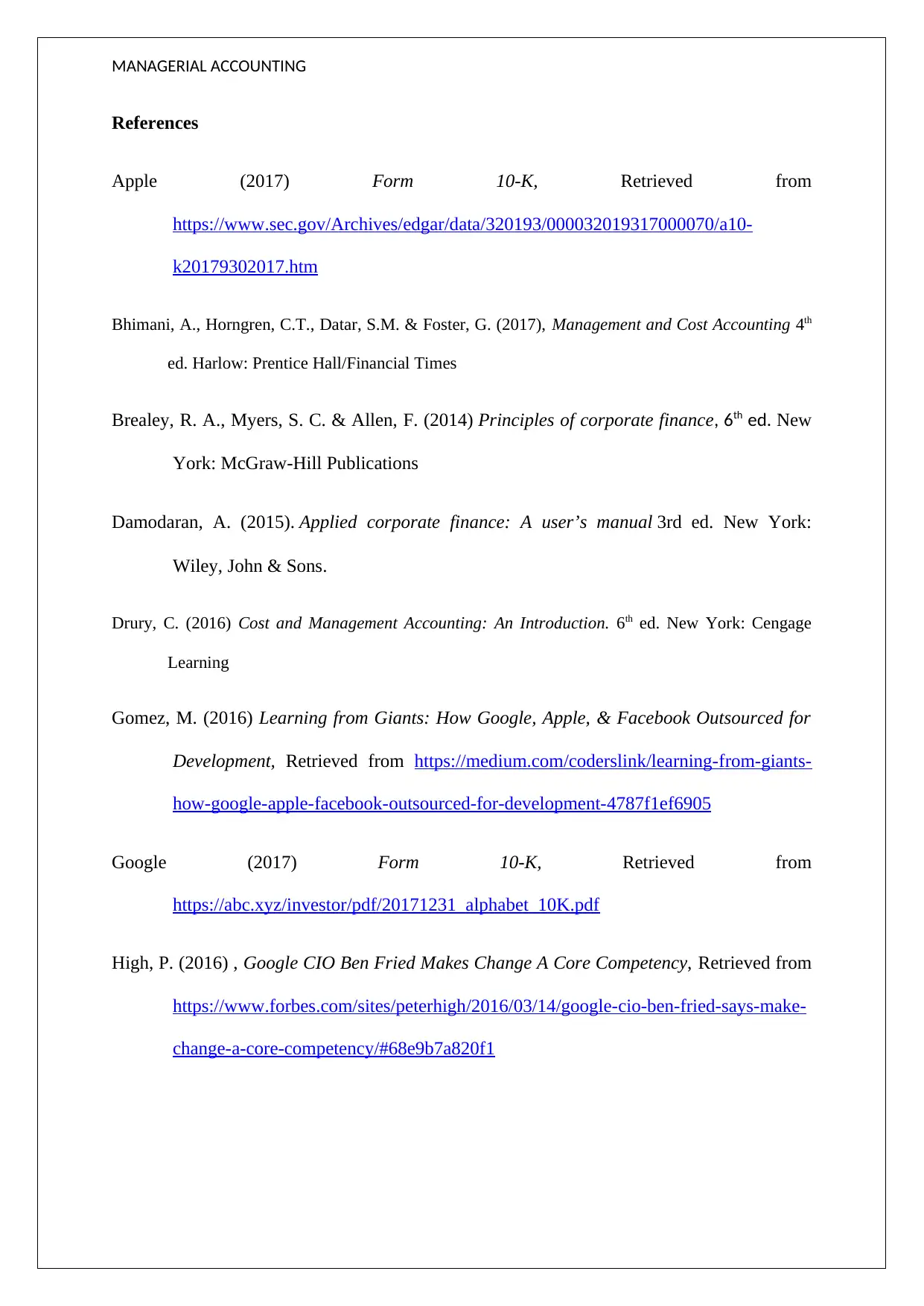
MANAGERIAL ACCOUNTING
References
Apple (2017) Form 10-K, Retrieved from
https://www.sec.gov/Archives/edgar/data/320193/000032019317000070/a10-
k20179302017.htm
Bhimani, A., Horngren, C.T., Datar, S.M. & Foster, G. (2017), Management and Cost Accounting 4th
ed. Harlow: Prentice Hall/Financial Times
Brealey, R. A., Myers, S. C. & Allen, F. (2014) Principles of corporate finance, 6th ed. New
York: McGraw-Hill Publications
Damodaran, A. (2015). Applied corporate finance: A user’s manual 3rd ed. New York:
Wiley, John & Sons.
Drury, C. (2016) Cost and Management Accounting: An Introduction. 6th ed. New York: Cengage
Learning
Gomez, M. (2016) Learning from Giants: How Google, Apple, & Facebook Outsourced for
Development, Retrieved from https://medium.com/coderslink/learning-from-giants-
how-google-apple-facebook-outsourced-for-development-4787f1ef6905
Google (2017) Form 10-K, Retrieved from
https://abc.xyz/investor/pdf/20171231_alphabet_10K.pdf
High, P. (2016) , Google CIO Ben Fried Makes Change A Core Competency, Retrieved from
https://www.forbes.com/sites/peterhigh/2016/03/14/google-cio-ben-fried-says-make-
change-a-core-competency/#68e9b7a820f1
References
Apple (2017) Form 10-K, Retrieved from
https://www.sec.gov/Archives/edgar/data/320193/000032019317000070/a10-
k20179302017.htm
Bhimani, A., Horngren, C.T., Datar, S.M. & Foster, G. (2017), Management and Cost Accounting 4th
ed. Harlow: Prentice Hall/Financial Times
Brealey, R. A., Myers, S. C. & Allen, F. (2014) Principles of corporate finance, 6th ed. New
York: McGraw-Hill Publications
Damodaran, A. (2015). Applied corporate finance: A user’s manual 3rd ed. New York:
Wiley, John & Sons.
Drury, C. (2016) Cost and Management Accounting: An Introduction. 6th ed. New York: Cengage
Learning
Gomez, M. (2016) Learning from Giants: How Google, Apple, & Facebook Outsourced for
Development, Retrieved from https://medium.com/coderslink/learning-from-giants-
how-google-apple-facebook-outsourced-for-development-4787f1ef6905
Google (2017) Form 10-K, Retrieved from
https://abc.xyz/investor/pdf/20171231_alphabet_10K.pdf
High, P. (2016) , Google CIO Ben Fried Makes Change A Core Competency, Retrieved from
https://www.forbes.com/sites/peterhigh/2016/03/14/google-cio-ben-fried-says-make-
change-a-core-competency/#68e9b7a820f1
1 out of 5
Related Documents
Your All-in-One AI-Powered Toolkit for Academic Success.
+13062052269
info@desklib.com
Available 24*7 on WhatsApp / Email
![[object Object]](/_next/static/media/star-bottom.7253800d.svg)
Unlock your academic potential
Copyright © 2020–2025 A2Z Services. All Rights Reserved. Developed and managed by ZUCOL.





